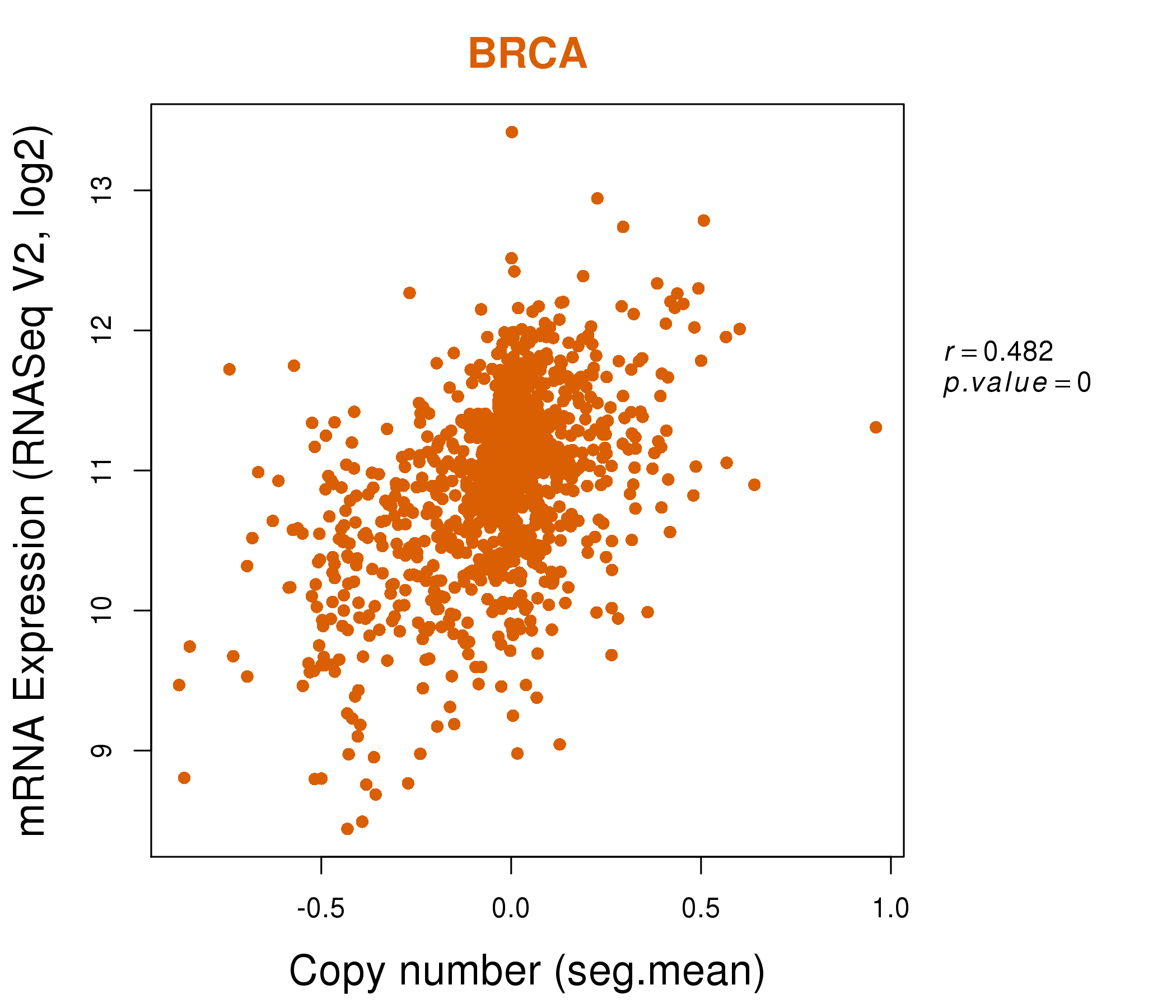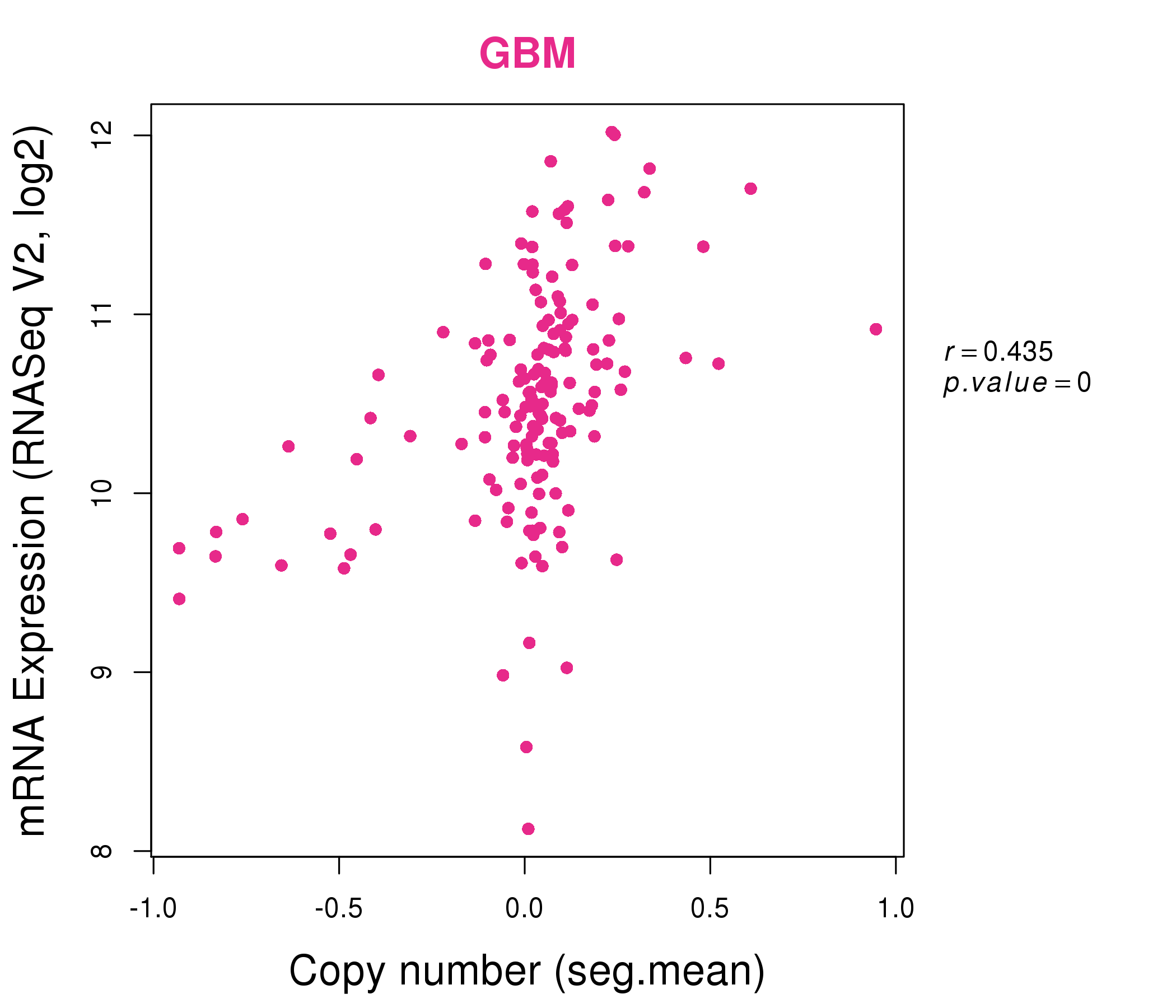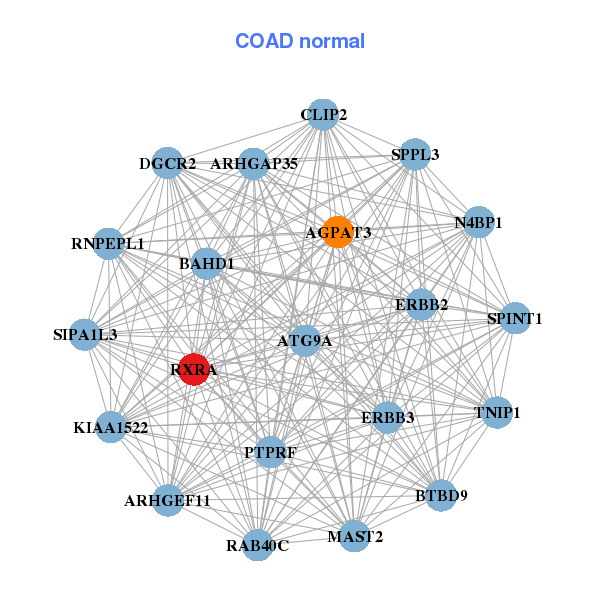|
||||||||||||||||||||||||||||||||||||||||||||||||||||||||||||||||||||||||||||||||||||||||||||||||||||||||||||||||||||||||||||||||||||||||||||||||||||||||||||||||||||||||||||||||||||||||||||||||||||||||||||||||||||||||||||||||||||||||||||||||||||||||||||||||||||||||||||||||||||||||||||||||||||||||||||||||||||||||||||||||||||||||||||||||||||||||||||||||||||||||||||||||||||||||||||||||||||||||||||||||||||||||||||||||||||||||||||||||||||||
| |
| Phenotypic Information (metabolism pathway, cancer, disease, phenome) |
| |
| |
| Gene-Gene Network Information: Co-Expression Network, Interacting Genes & KEGG |
| |
|
| Gene Summary for RXRA |
| Basic gene info. | Gene symbol | RXRA |
| Gene name | retinoid X receptor, alpha | |
| Synonyms | NR2B1 | |
| Cytomap | UCSC genome browser: 9q34.3 | |
| Genomic location | chr9 :137218315-137332431 | |
| Type of gene | protein-coding | |
| RefGenes | NM_001291920.1, NM_001291921.1,NM_002957.5, | |
| Ensembl id | ENSG00000269571 | |
| Description | nuclear receptor subfamily 2 group B member 1retinoic acid receptor RXR-alpharetinoid X nuclear receptor alpha | |
| Modification date | 20141222 | |
| dbXrefs | MIM : 180245 | |
| HGNC : HGNC | ||
| HPRD : 01577 | ||
| Protein | UniProt: P19793 go to UniProt's Cross Reference DB Table | |
| Expression | CleanEX: HS_RXRA | |
| BioGPS: 6256 | ||
| Gene Expression Atlas: ENSG00000269571 | ||
| The Human Protein Atlas: ENSG00000269571 | ||
| Pathway | NCI Pathway Interaction Database: RXRA | |
| KEGG: RXRA | ||
| REACTOME: RXRA | ||
| ConsensusPathDB | ||
| Pathway Commons: RXRA | ||
| Metabolism | MetaCyc: RXRA | |
| HUMANCyc: RXRA | ||
| Regulation | Ensembl's Regulation: ENSG00000269571 | |
| miRBase: chr9 :137,218,315-137,332,431 | ||
| TargetScan: NM_001291920 | ||
| cisRED: ENSG00000269571 | ||
| Context | iHOP: RXRA | |
| cancer metabolism search in PubMed: RXRA | ||
| UCL Cancer Institute: RXRA | ||
| Assigned class in ccmGDB | A - This gene has a literature evidence and it belongs to cancer gene. | |
| References showing role of RXRA in cancer cell metabolism | 1. Deepa PR, Vandhana S, Krishnakumar S (2013) Fatty acid synthase inhibition induces differential expression of genes involved in apoptosis and cell proliferation in ocular cancer cells. Nutrition and cancer 65: 311-316. go to article | |
| Top |
| Phenotypic Information for RXRA(metabolism pathway, cancer, disease, phenome) |
| Cancer | CGAP: RXRA |
| Familial Cancer Database: RXRA | |
| * This gene is included in those cancer gene databases. |
|
|
|
|
|
| . | ||||||||||||||||||||||||||||||||||||||||||||||||||||||||||||||||||||||||||||||||||||||||||||||||||||||||||||||||||||||||||||||||||||||||||||||||||||||||||||||||||||||||||||||||||||||||||||||||||||||||||||||||||||||||||||||||||||||||||||||||||||||||||||||||||||||||||||||||||||||||||||||||||||||||||||||||||||||||||||||||||||||||||||||||||||||||||||||||||||||||||||||||||||||||||||||||||||||||||||||||||||||||||||||||||||||||||||||||
Oncogene 1 | Significant driver gene in BLCA 6, | |||||||||||||||||||||||||||||||||||||||||||||||||||||||||||||||||||||||||||||||||||||||||||||||||||||||||||||||||||||||||||||||||||||||||||||||||||||||||||||||||||||||||||||||||||||||||||||||||||||||||||||||||||||||||||||||||||||||||||||||||||||||||||||||||||||||||||||||||||||||||||||||||||||||||||||||||||||||||||||||||||||||||||||||||||||||||||||||||||||||||||||||||||||||||||||||||||||||||||||||||||||||||||||||||||||||||||||||||||||
| cf) number; DB name 1 Oncogene; http://nar.oxfordjournals.org/content/35/suppl_1/D721.long, 2 Tumor Suppressor gene; https://bioinfo.uth.edu/TSGene/, 3 Cancer Gene Census; http://www.nature.com/nrc/journal/v4/n3/abs/nrc1299.html, 4 CancerGenes; http://nar.oxfordjournals.org/content/35/suppl_1/D721.long, 5 Network of Cancer Gene; http://ncg.kcl.ac.uk/index.php, 6 http://www.nature.com/nature/journal/vaop/ncurrent/full/nature12965.html, 7Therapeutic Vulnerabilities in Cancer; http://cbio.mskcc.org/cancergenomics/statius/ |
| REACTOME_METABOLISM_OF_LIPIDS_AND_LIPOPROTEINS | |
| OMIM | 180245; gene. |
| Orphanet | |
| Disease | KEGG Disease: RXRA |
| MedGen: RXRA (Human Medical Genetics with Condition) | |
| ClinVar: RXRA | |
| Phenotype | MGI: RXRA (International Mouse Phenotyping Consortium) |
| PhenomicDB: RXRA | |
| Mutations for RXRA |
| * Under tables are showing count per each tissue to give us broad intuition about tissue specific mutation patterns.You can go to the detailed page for each mutation database's web site. |
| - Statistics for Tissue and Mutation type | Top |
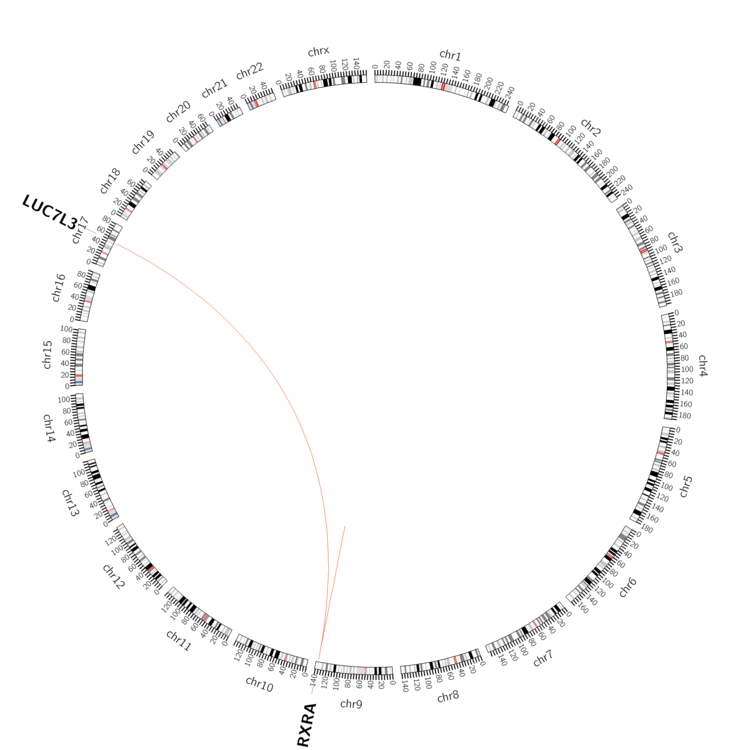 |
| - For Inter-chromosomal Variations |
| * Inter-chromosomal variantions includes 'interchromosomal amplicon to amplicon', 'interchromosomal amplicon to non-amplified dna', 'interchromosomal insertion', 'Interchromosomal unknown type'. |
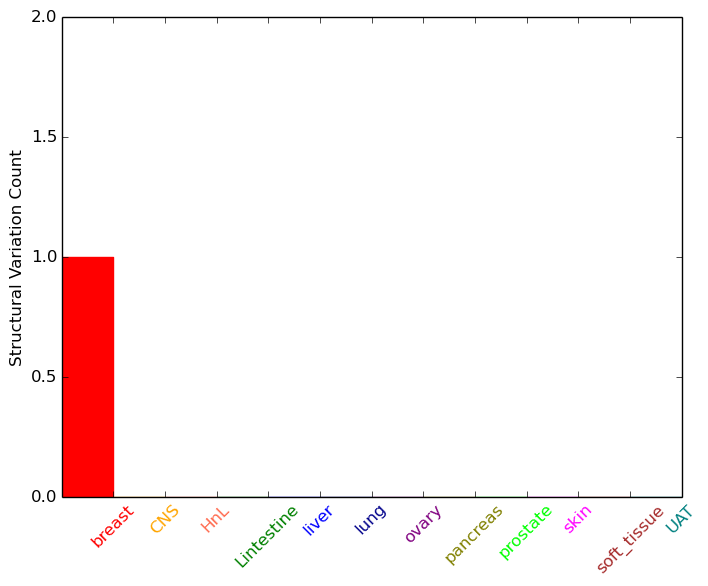 |
| - For Intra-chromosomal Variations |
| * Intra-chromosomal variantions includes 'intrachromosomal amplicon to amplicon', 'intrachromosomal amplicon to non-amplified dna', 'intrachromosomal deletion', 'intrachromosomal fold-back inversion', 'intrachromosomal inversion', 'intrachromosomal tandem duplication', 'Intrachromosomal unknown type', 'intrachromosomal with inverted orientation', 'intrachromosomal with non-inverted orientation'. |
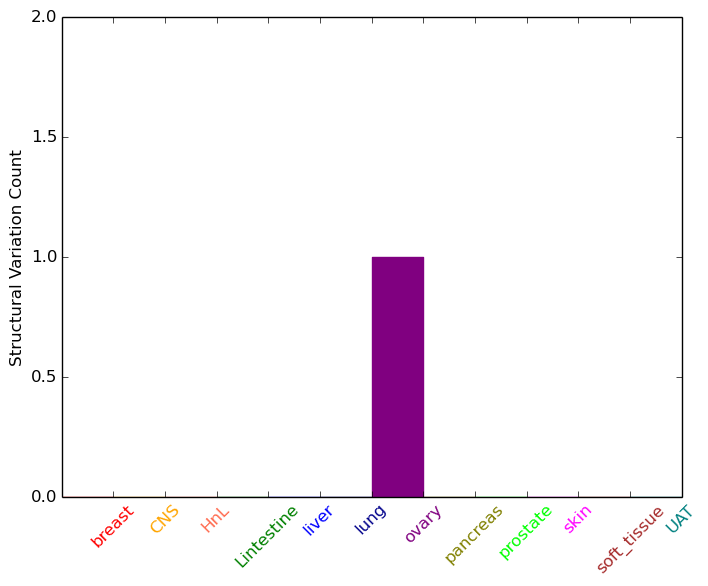 |
| Sample | Symbol_a | Chr_a | Start_a | End_a | Symbol_b | Chr_b | Start_b | End_b |
| breast | RXRA | chr9 | 137221922 | 137222322 | LUC7L3 | chr17 | 48819027 | 48819427 |
| ovary | RXRA | chr9 | 137303708 | 137303728 | RXRA | chr9 | 137305107 | 137305127 |
| cf) Tissue number; Tissue name (1;Breast, 2;Central_nervous_system, 3;Haematopoietic_and_lymphoid_tissue, 4;Large_intestine, 5;Liver, 6;Lung, 7;Ovary, 8;Pancreas, 9;Prostate, 10;Skin, 11;Soft_tissue, 12;Upper_aerodigestive_tract) |
| * From mRNA Sanger sequences, Chitars2.0 arranged chimeric transcripts. This table shows RXRA related fusion information. |
| ID | Head Gene | Tail Gene | Accession | Gene_a | qStart_a | qEnd_a | Chromosome_a | tStart_a | tEnd_a | Gene_a | qStart_a | qEnd_a | Chromosome_a | tStart_a | tEnd_a |
| AW881282 | RXRA | 30 | 291 | 9 | 137328444 | 137328705 | RXRA | 288 | 368 | 9 | 137325987 | 137328326 | |
| AW881216 | RXRA | 8 | 276 | 9 | 137328437 | 137328705 | RXRA | 273 | 360 | 9 | 137325987 | 137328333 | |
| BM978893 | RXRA | 19 | 107 | 9 | 137332343 | 137332431 | LRBA | 106 | 610 | 4 | 151283588 | 151284092 | |
| Top |
| Mutation type/ Tissue ID | brca | cns | cerv | endome | haematopo | kidn | Lintest | liver | lung | ns | ovary | pancre | prost | skin | stoma | thyro | urina | |||
| Total # sample | 1 | 1 | ||||||||||||||||||
| GAIN (# sample) | ||||||||||||||||||||
| LOSS (# sample) | 1 | 1 |
| cf) Tissue ID; Tissue type (1; Breast, 2; Central_nervous_system, 3; Cervix, 4; Endometrium, 5; Haematopoietic_and_lymphoid_tissue, 6; Kidney, 7; Large_intestine, 8; Liver, 9; Lung, 10; NS, 11; Ovary, 12; Pancreas, 13; Prostate, 14; Skin, 15; Stomach, 16; Thyroid, 17; Urinary_tract) |
| Top |
|
 |
| Top |
| Stat. for Non-Synonymous SNVs (# total SNVs=26) | (# total SNVs=16) |
 | 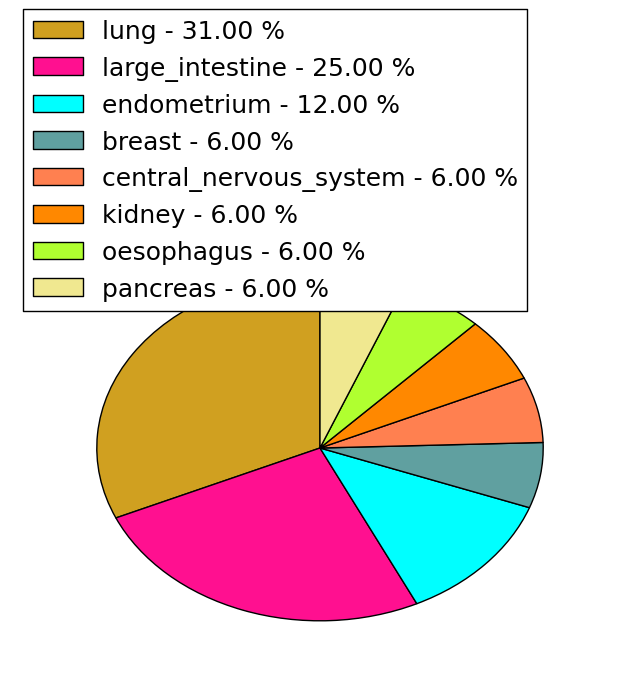 |
(# total SNVs=2) | (# total SNVs=0) |
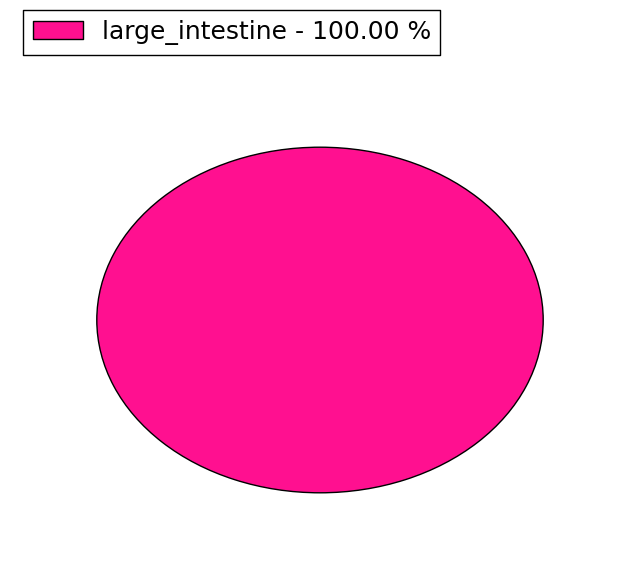 |
| Top |
| * When you move the cursor on each content, you can see more deailed mutation information on the Tooltip. Those are primary_site,primary_histology,mutation(aa),pubmedID. |
| GRCh37 position | Mutation(aa) | Unique sampleID count |
| chr9:137328351-137328351 | p.S427F | 16 |
| chr9:137328442-137328442 | p.A457A | 2 |
| chr9:137328331-137328331 | p.L420L | 2 |
| chr9:137300040-137300040 | p.P109S | 2 |
| chr9:137309028-137309028 | p.G212D | 2 |
| chr9:137328348-137328348 | p.R426H | 2 |
| chr9:137300840-137300840 | p.T162M | 2 |
| chr9:137309085-137309085 | p.P231L | 2 |
| chr9:137309139-137309139 | p.Y249F | 2 |
| chr9:137320990-137320990 | p.R316L | 2 |
| Top |
|
 |
| Point Mutation/ Tissue ID | 1 | 2 | 3 | 4 | 5 | 6 | 7 | 8 | 9 | 10 | 11 | 12 | 13 | 14 | 15 | 16 | 17 | 18 | 19 | 20 |
| # sample | 13 | 1 | 8 | 2 | 4 | 1 | 1 | 5 | 1 | 3 | 6 | 1 | 4 | |||||||
| # mutation | 7 | 1 | 8 | 2 | 4 | 1 | 1 | 5 | 1 | 3 | 7 | 1 | 4 | |||||||
| nonsynonymous SNV | 6 | 1 | 6 | 2 | 4 | 1 | 2 | 1 | 3 | 5 | 2 | |||||||||
| synonymous SNV | 1 | 2 | 1 | 3 | 2 | 1 | 2 |
| cf) Tissue ID; Tissue type (1; BLCA[Bladder Urothelial Carcinoma], 2; BRCA[Breast invasive carcinoma], 3; CESC[Cervical squamous cell carcinoma and endocervical adenocarcinoma], 4; COAD[Colon adenocarcinoma], 5; GBM[Glioblastoma multiforme], 6; Glioma Low Grade, 7; HNSC[Head and Neck squamous cell carcinoma], 8; KICH[Kidney Chromophobe], 9; KIRC[Kidney renal clear cell carcinoma], 10; KIRP[Kidney renal papillary cell carcinoma], 11; LAML[Acute Myeloid Leukemia], 12; LUAD[Lung adenocarcinoma], 13; LUSC[Lung squamous cell carcinoma], 14; OV[Ovarian serous cystadenocarcinoma ], 15; PAAD[Pancreatic adenocarcinoma], 16; PRAD[Prostate adenocarcinoma], 17; SKCM[Skin Cutaneous Melanoma], 18:STAD[Stomach adenocarcinoma], 19:THCA[Thyroid carcinoma], 20:UCEC[Uterine Corpus Endometrial Carcinoma]) |
| Top |
| * We represented just top 10 SNVs. When you move the cursor on each content, you can see more deailed mutation information on the Tooltip. Those are primary_site, primary_histology, mutation(aa), pubmedID. |
| Genomic Position | Mutation(aa) | Unique sampleID count |
| chr9:137328351 | p.S330F,RXRA | 7 |
| chr9:137320990 | p.R219H,RXRA | 2 |
| chr9:137326002 | p.A290S,RXRA | 1 |
| chr9:137293577 | p.S27C | 1 |
| chr9:137328442 | p.N77I,RXRA | 1 |
| chr9:137300801 | p.Y300C,RXRA | 1 |
| chr9:137313574 | p.S16F,RXRA | 1 |
| chr9:137326047 | p.L81V,RXRA | 1 |
| chr9:137293588 | p.P315Q,RXRA | 1 |
| chr9:137300840 | p.L20V,RXRA | 1 |
| * Copy number data were extracted from TCGA using R package TCGA-Assembler. The URLs of all public data files on TCGA DCC data server were gathered on Jan-05-2015. Function ProcessCNAData in TCGA-Assembler package was used to obtain gene-level copy number value which is calculated as the average copy number of the genomic region of a gene. |
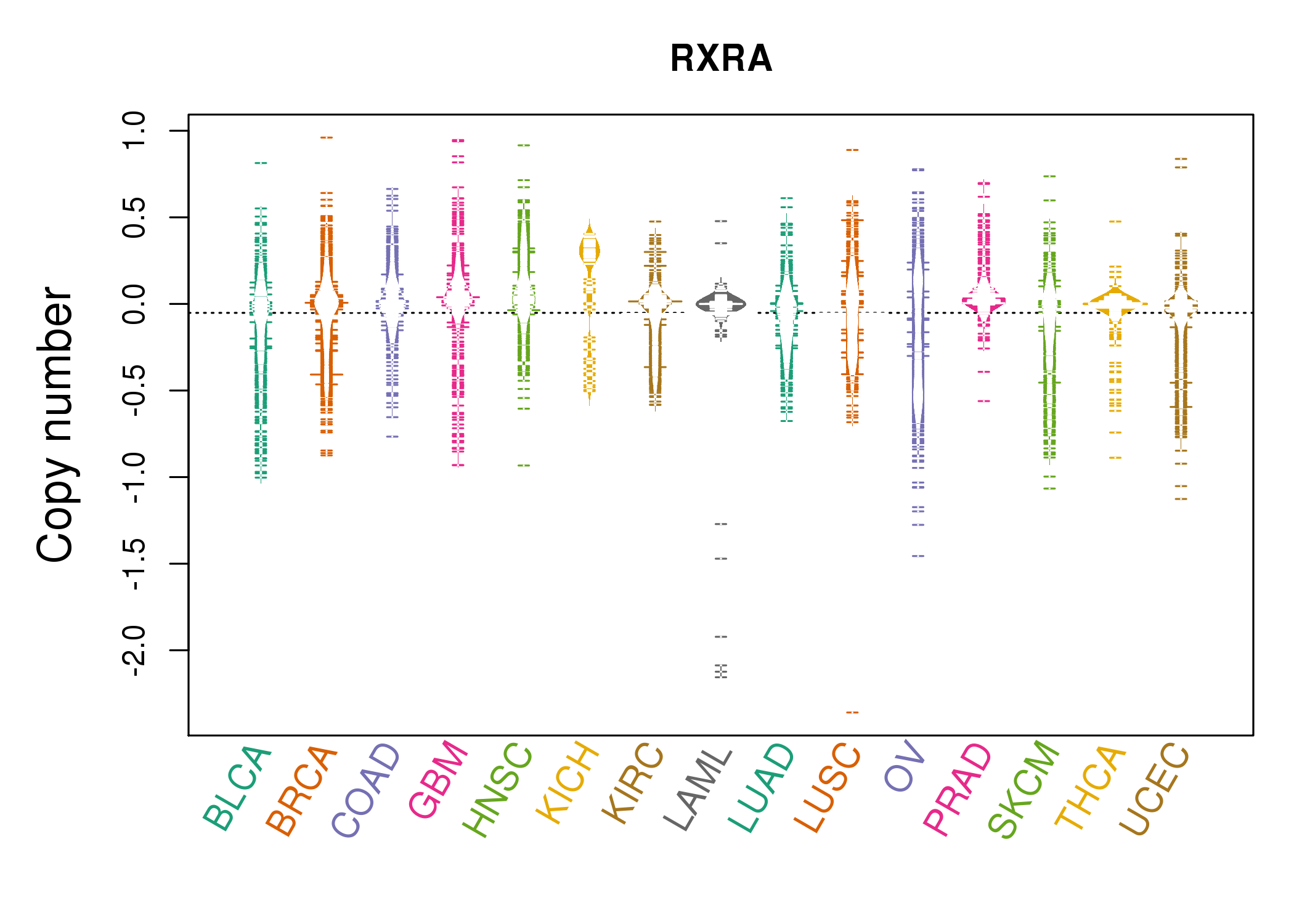 |
| cf) Tissue ID[Tissue type]: BLCA[Bladder Urothelial Carcinoma], BRCA[Breast invasive carcinoma], CESC[Cervical squamous cell carcinoma and endocervical adenocarcinoma], COAD[Colon adenocarcinoma], GBM[Glioblastoma multiforme], Glioma Low Grade, HNSC[Head and Neck squamous cell carcinoma], KICH[Kidney Chromophobe], KIRC[Kidney renal clear cell carcinoma], KIRP[Kidney renal papillary cell carcinoma], LAML[Acute Myeloid Leukemia], LUAD[Lung adenocarcinoma], LUSC[Lung squamous cell carcinoma], OV[Ovarian serous cystadenocarcinoma ], PAAD[Pancreatic adenocarcinoma], PRAD[Prostate adenocarcinoma], SKCM[Skin Cutaneous Melanoma], STAD[Stomach adenocarcinoma], THCA[Thyroid carcinoma], UCEC[Uterine Corpus Endometrial Carcinoma] |
| Top |
| Gene Expression for RXRA |
| * CCLE gene expression data were extracted from CCLE_Expression_Entrez_2012-10-18.res: Gene-centric RMA-normalized mRNA expression data. |
 |
| * Normalized gene expression data of RNASeqV2 was extracted from TCGA using R package TCGA-Assembler. The URLs of all public data files on TCGA DCC data server were gathered at Jan-05-2015. Only eight cancer types have enough normal control samples for differential expression analysis. (t test, adjusted p<0.05 (using Benjamini-Hochberg FDR)) |
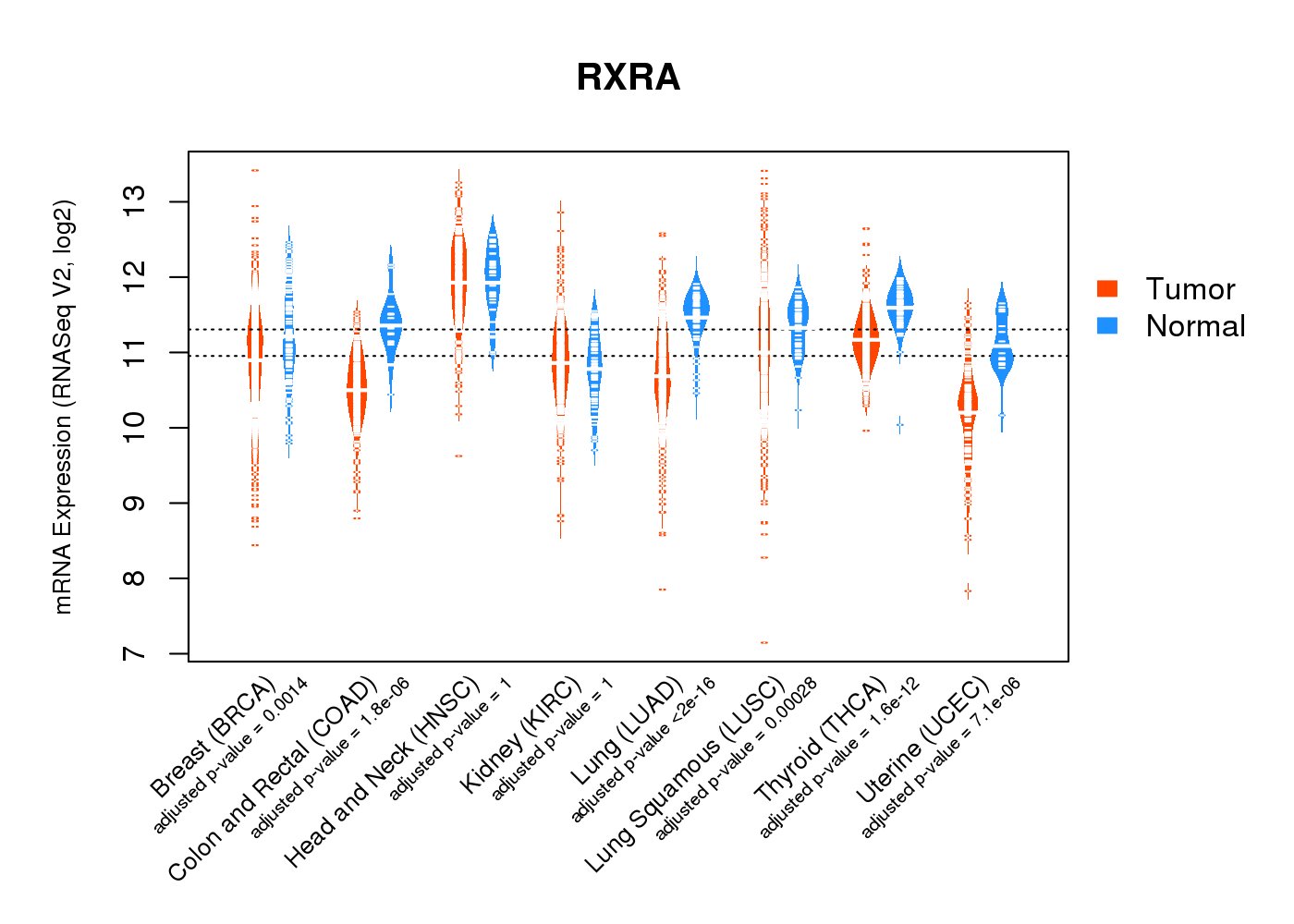 |
| Top |
| * This plots show the correlation between CNV and gene expression. |
: Open all plots for all cancer types
 |
|
 |
|
| Top |
| Gene-Gene Network Information |
| * Co-Expression network figures were drawn using R package igraph. Only the top 20 genes with the highest correlations were shown. Red circle: input gene, orange circle: cell metabolism gene, sky circle: other gene |
: Open all plots for all cancer types
 |
| ||||
| ABCA2,ALAD,ANAPC2,PRRC2B,CACFD1,EHMT1,FAM73B, JMJD7-PLA2G4B,PPP1R26,MED22,MXD4,NDOR1,PKD1,PPP2R4, RGS12,RXRA,TAOK2,TBC1D13,TNRC18,USP20,ZER1 | ABCD1,ACADS,AGPAT2,ALDH2,ANXA6,ADIRF,C14orf180, CAMK1,CEBPA,COL4A2,CSPG4,GYPC,ITGA7,LOC80054, PLA2G16,PNPLA2,POLR2E,PPP1R1A,RXRA,ST6GALNAC6,TMEM132C | ||||
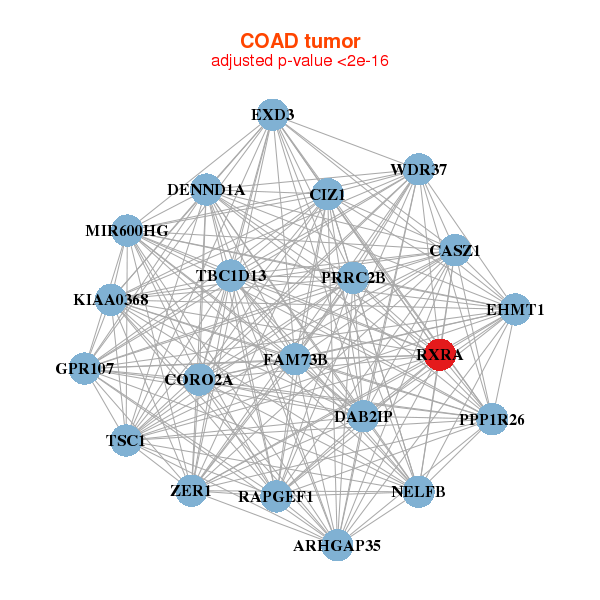 |
| ||||
| PRRC2B,MIR600HG,CASZ1,CIZ1,NELFB,CORO2A,DAB2IP, DENND1A,EHMT1,EXD3,FAM73B,GPR107,ARHGAP35,KIAA0368, PPP1R26,RAPGEF1,RXRA,TBC1D13,TSC1,WDR37,ZER1 | AGPAT3,ARHGEF11,ATG9A,BAHD1,BTBD9,CLIP2,DGCR2, ERBB2,ERBB3,ARHGAP35,KIAA1522,MAST2,N4BP1,PTPRF, RAB40C,RNPEPL1,RXRA,SIPA1L3,SPINT1,SPPL3,TNIP1 |
| * Co-Expression network figures were drawn using R package igraph. Only the top 20 genes with the highest correlations were shown. Red circle: input gene, orange circle: cell metabolism gene, sky circle: other gene |
: Open all plots for all cancer types
| Top |
: Open all interacting genes' information including KEGG pathway for all interacting genes from DAVID
| Top |
| Pharmacological Information for RXRA |
| DB Category | DB Name | DB's ID and Url link |
| Chemistry | BindingDB | P19793; -. |
| Chemistry | ChEMBL | CHEMBL2363071; -. |
| Chemistry | GuidetoPHARMACOLOGY | 610; -. |
| Organism-specific databases | PharmGKB | PA34890; -. |
| Organism-specific databases | CTD | 6256; -. |
| * Gene Centered Interaction Network. |
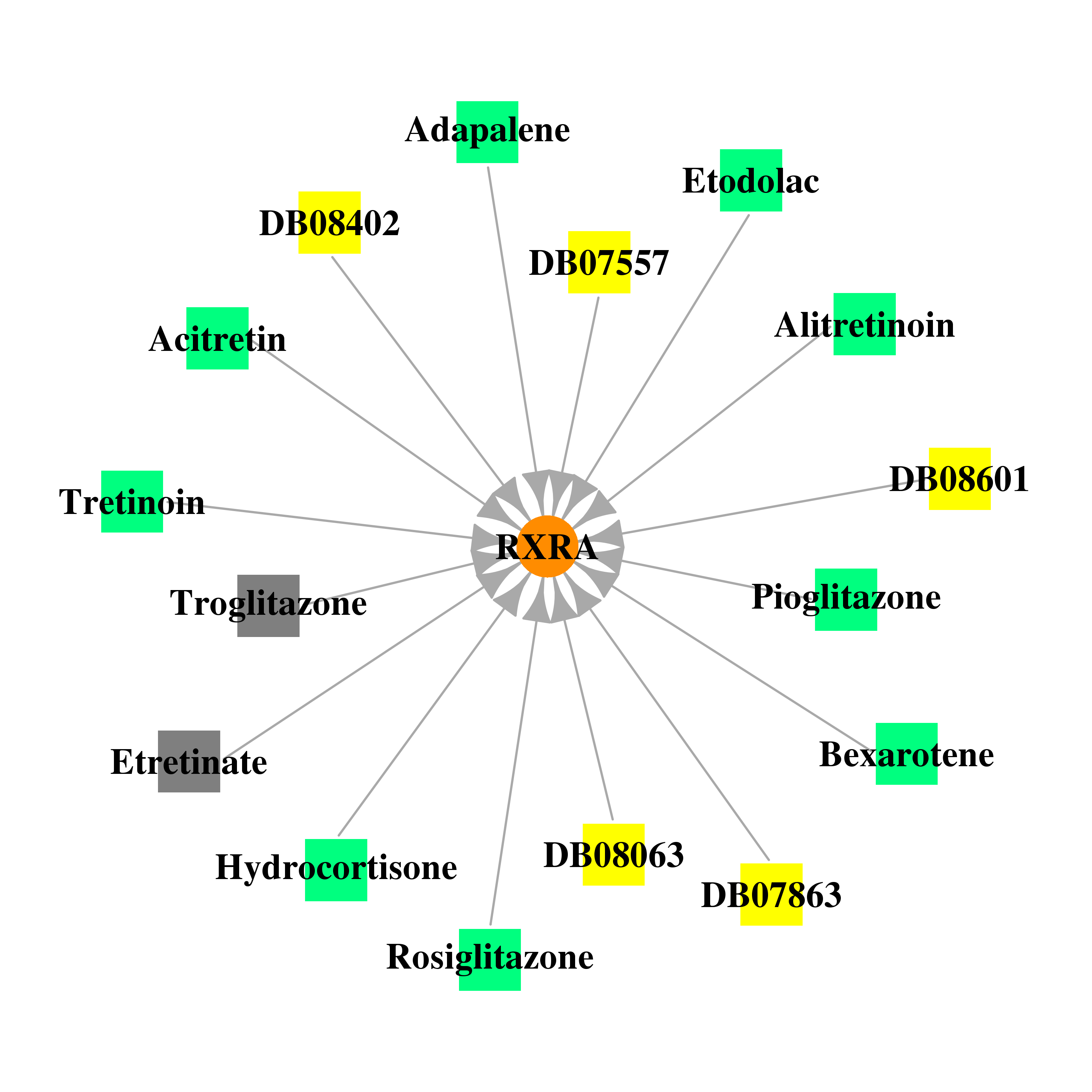 |
| * Drug Centered Interaction Network. |
| DrugBank ID | Target Name | Drug Groups | Generic Name | Drug Centered Network | Drug Structure |
| DB00210 | retinoid X receptor, alpha | approved | Adapalene | 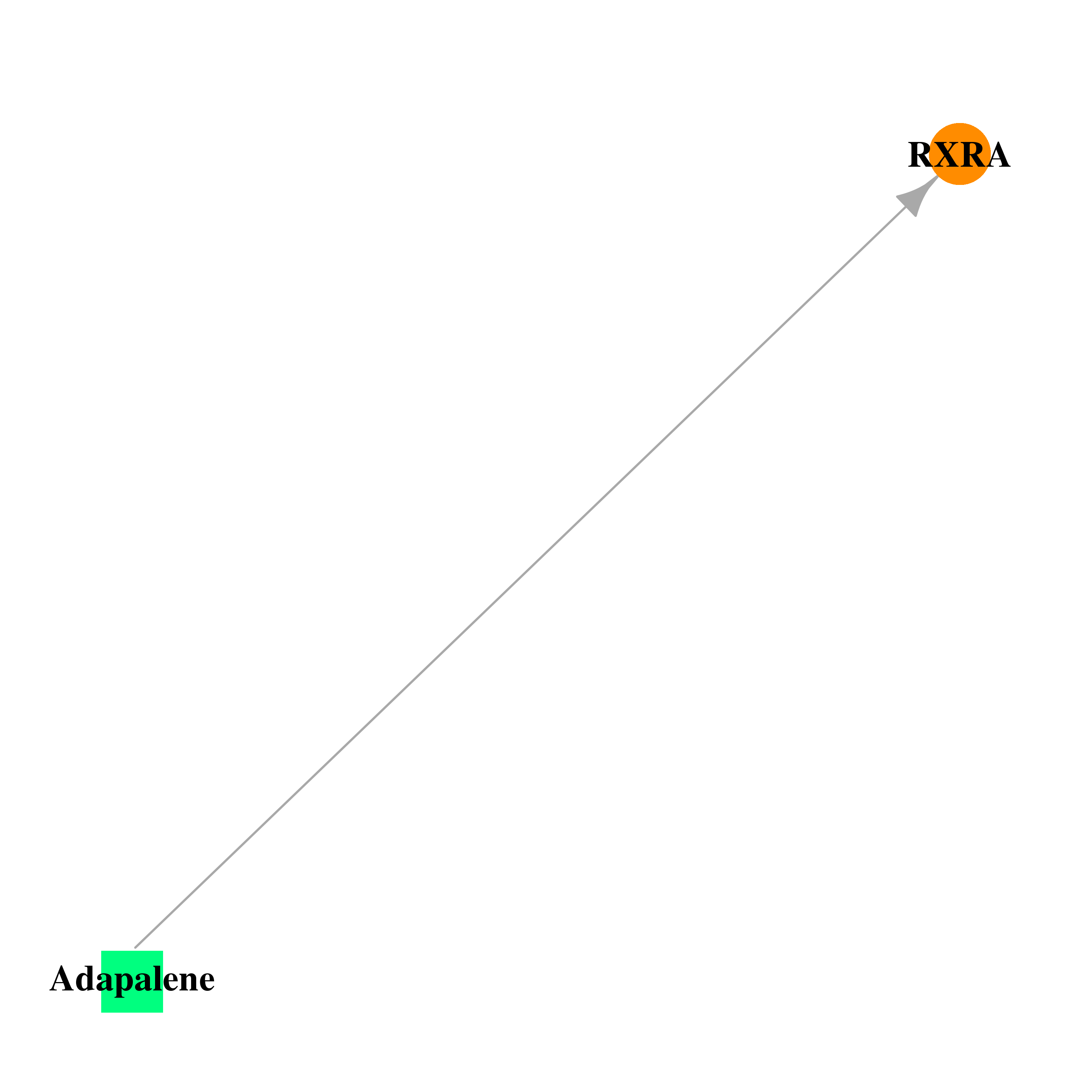 |  |
| DB00307 | retinoid X receptor, alpha | approved; investigational | Bexarotene | 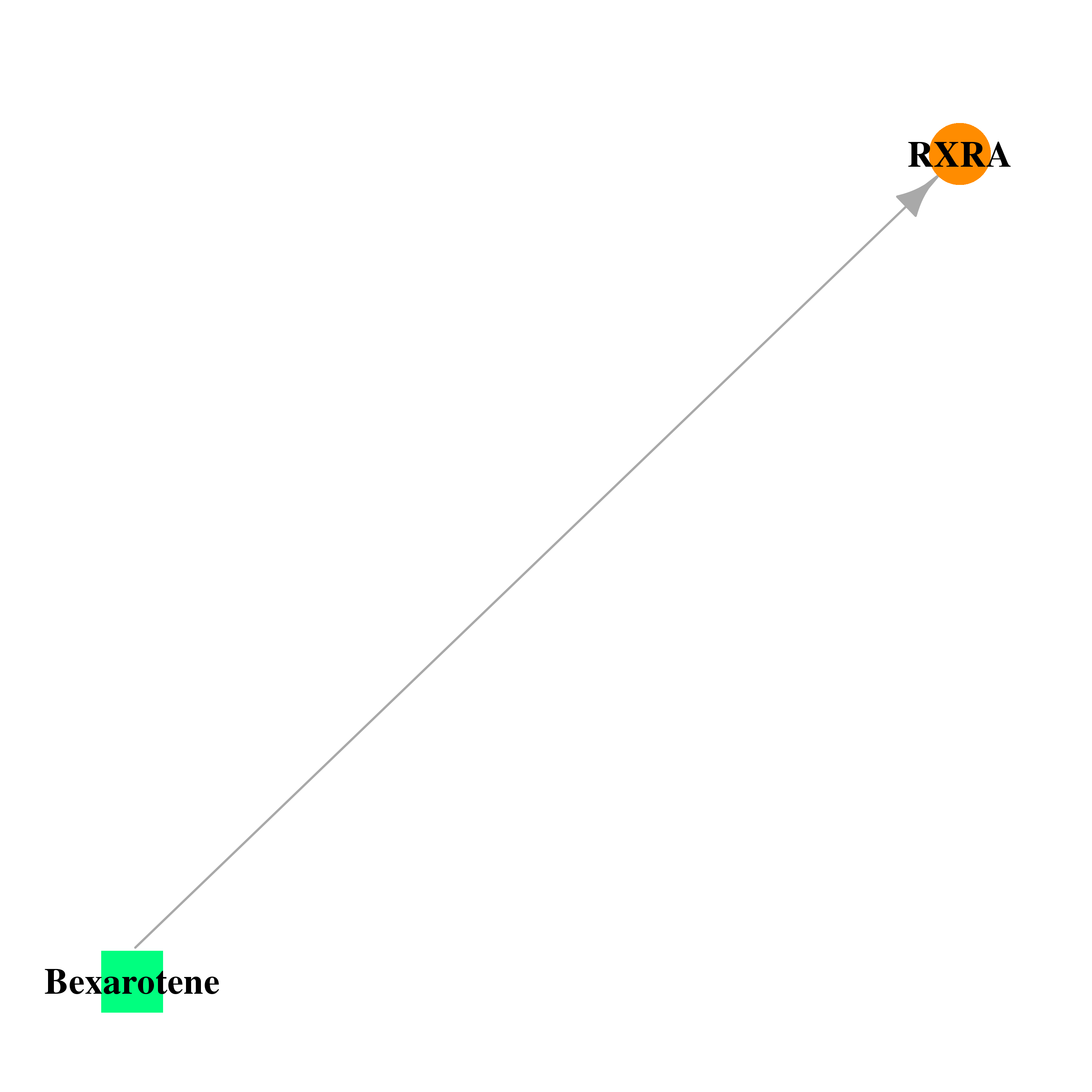 | 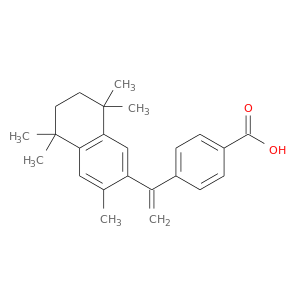 |
| DB00459 | retinoid X receptor, alpha | approved | Acitretin | 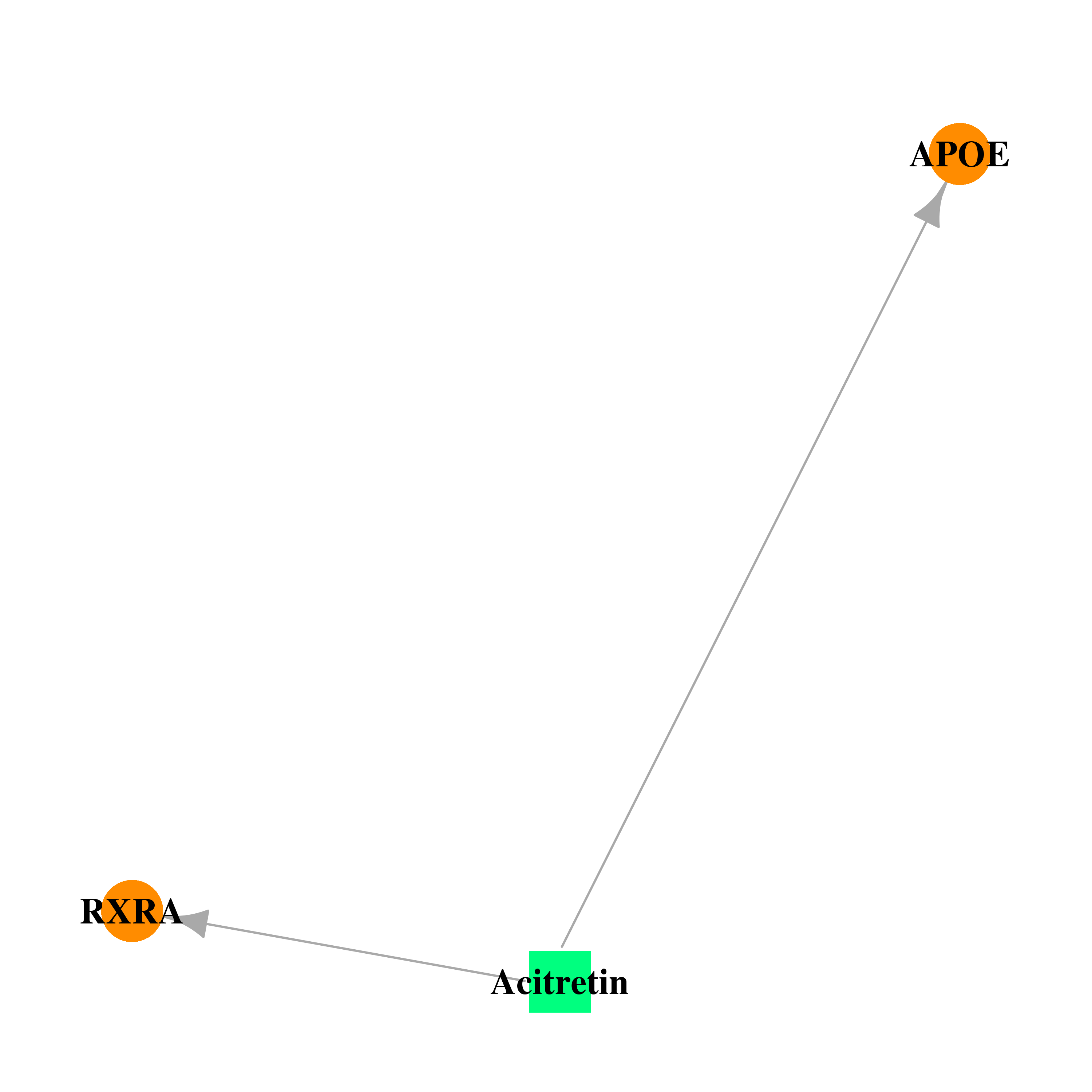 |  |
| DB00523 | retinoid X receptor, alpha | approved; investigational | Alitretinoin |  |  |
| DB00749 | retinoid X receptor, alpha | approved; investigational | Etodolac | 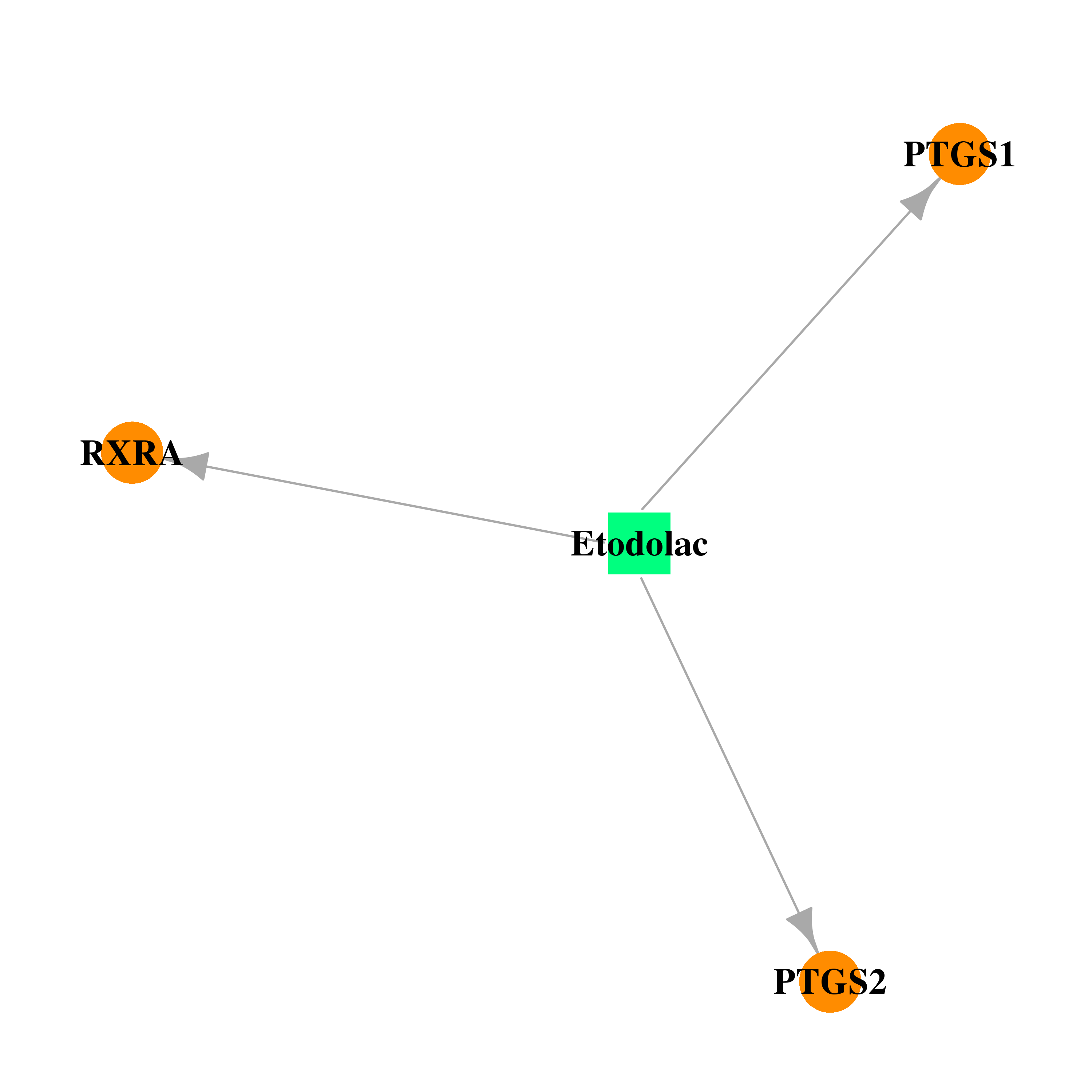 |  |
| DB00926 | retinoid X receptor, alpha | withdrawn | Etretinate | 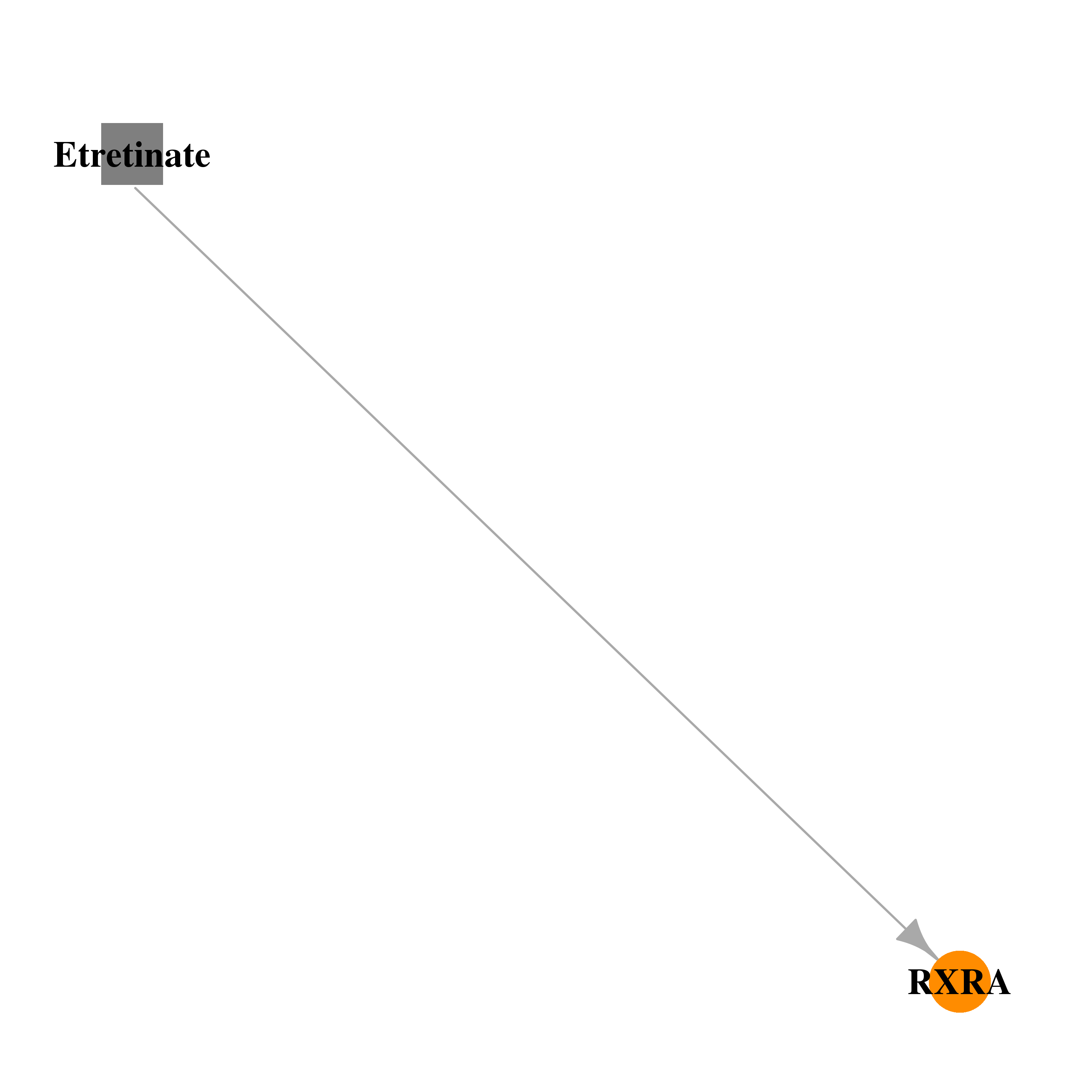 | 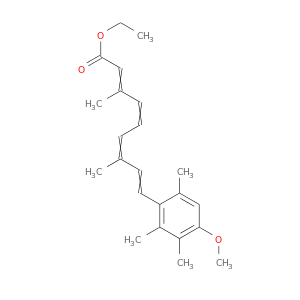 |
| DB07557 | retinoid X receptor, alpha | experimental | (5BETA)-PREGNANE-3,20-DIONE |  | 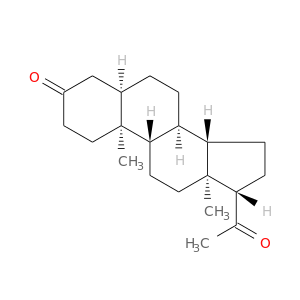 |
| DB07863 | retinoid X receptor, alpha | experimental | 2-chloro-5-nitro-N-phenylbenzamide |  |  |
| DB08063 | retinoid X receptor, alpha | experimental | 1-BENZYL-3-(4-METHOXYPHENYLAMINO)-4-PHENYLPYRROLE-2,5-DIONE | 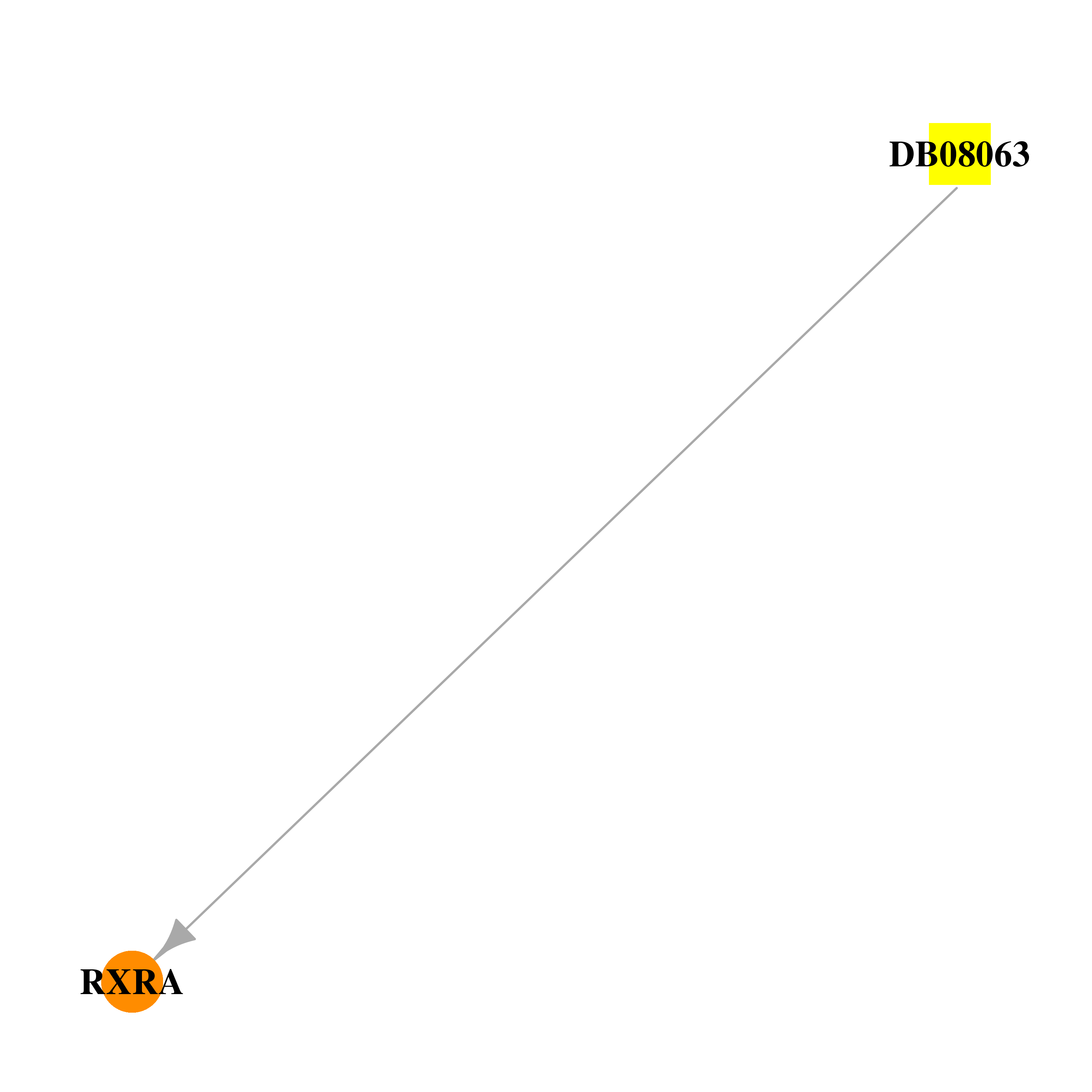 | 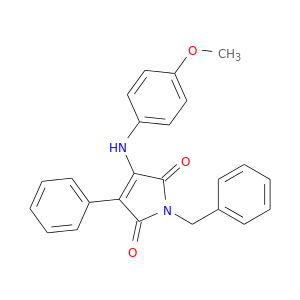 |
| DB08402 | retinoid X receptor, alpha | experimental | 2-[(2,4-DICHLOROBENZOYL)AMINO]-5-(PYRIMIDIN-2-YLOXY)BENZOIC ACID | 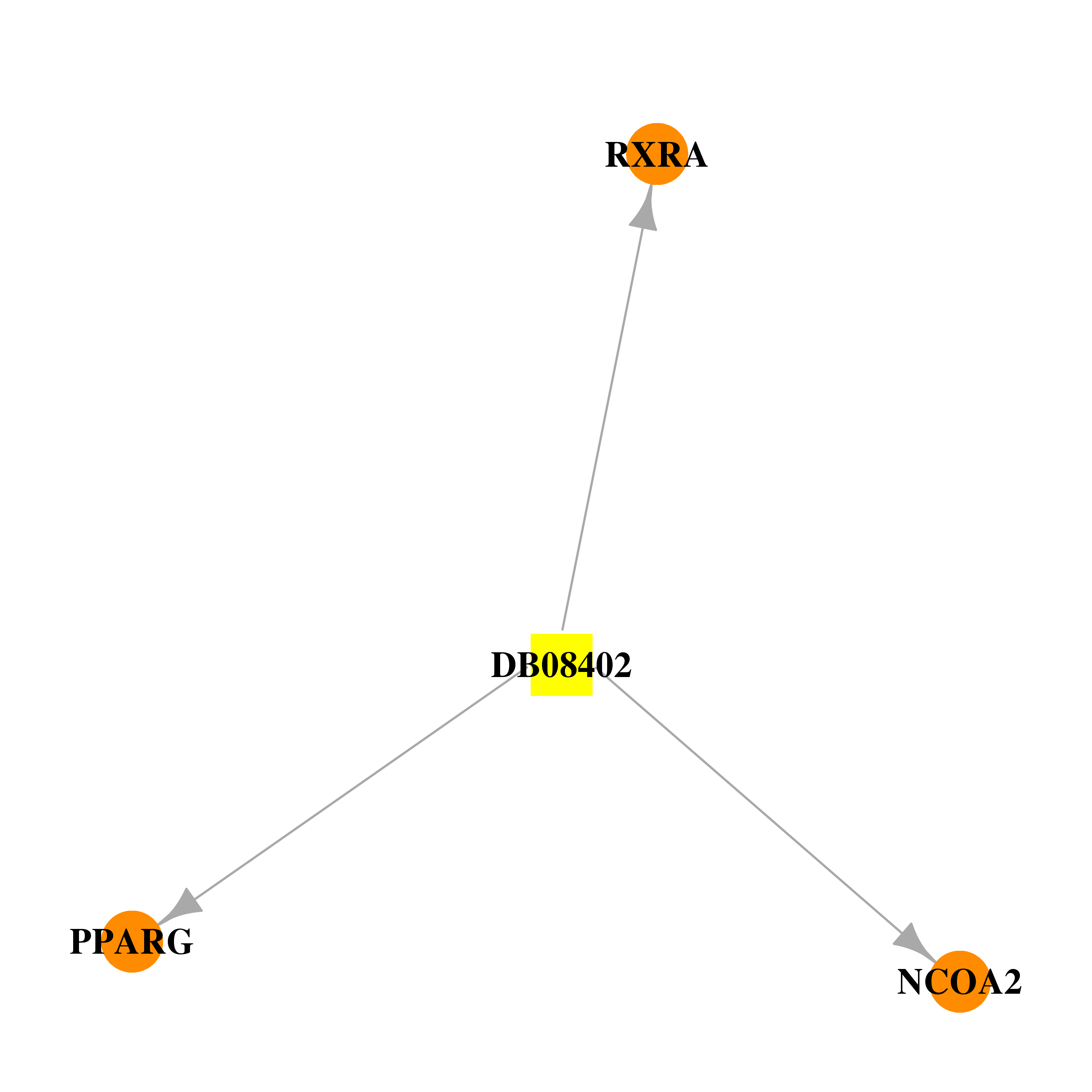 |  |
| DB08601 | retinoid X receptor, alpha | experimental | tributylstannanyl |  |  |
| DB00755 | retinoid X receptor, alpha | approved; nutraceutical; investigational | Tretinoin |  |  |
| DB00741 | retinoid X receptor, alpha | approved | Hydrocortisone |  |  |
| DB01132 | retinoid X receptor, alpha | approved; investigational | Pioglitazone |  | 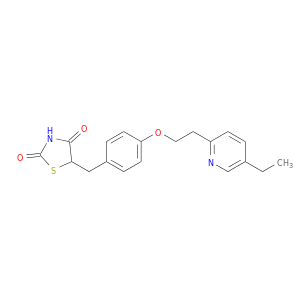 |
| DB00412 | retinoid X receptor, alpha | approved; investigational | Rosiglitazone | 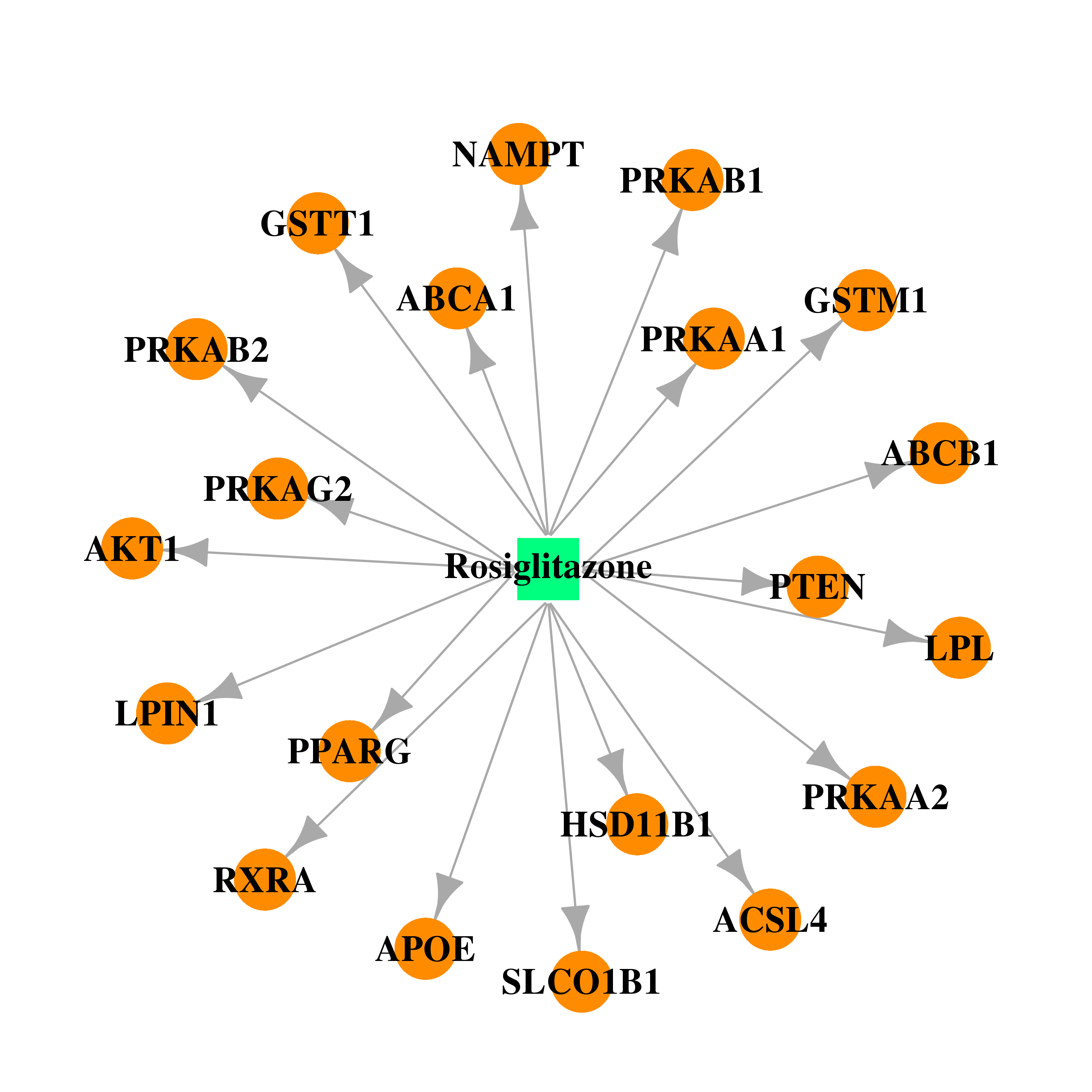 |  |
| DB00197 | retinoid X receptor, alpha | withdrawn | Troglitazone |  |  |
| Top |
| Cross referenced IDs for RXRA |
| * We obtained these cross-references from Uniprot database. It covers 150 different DBs, 18 categories. http://www.uniprot.org/help/cross_references_section |
: Open all cross reference information
|
Copyright © 2016-Present - The Univsersity of Texas Health Science Center at Houston @ |






